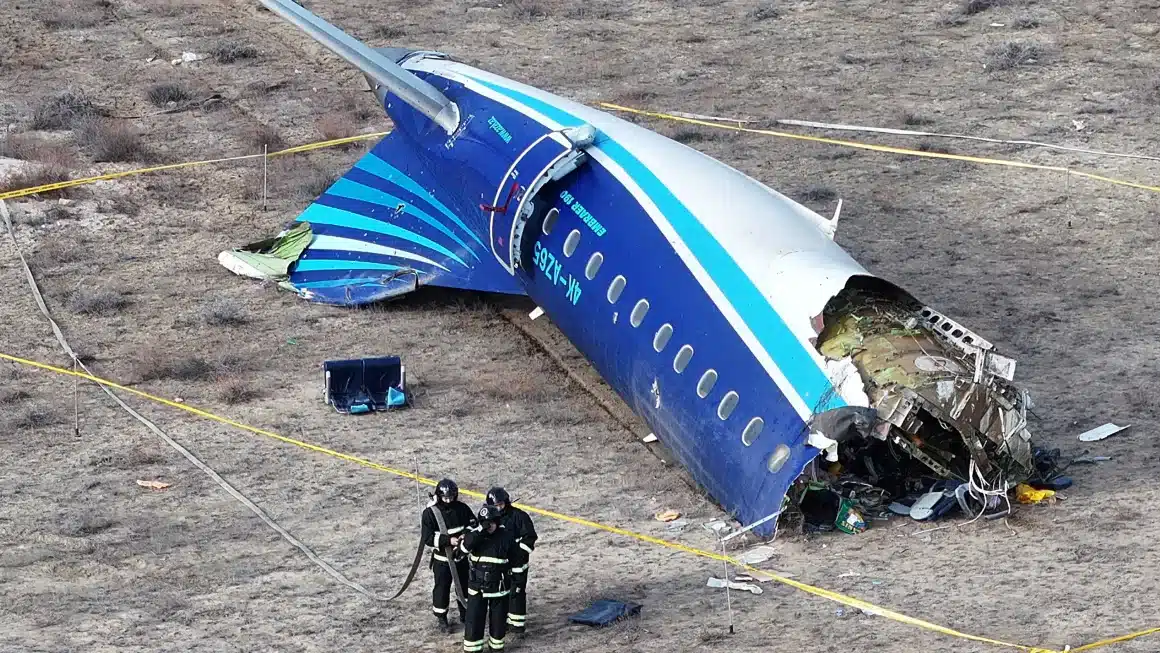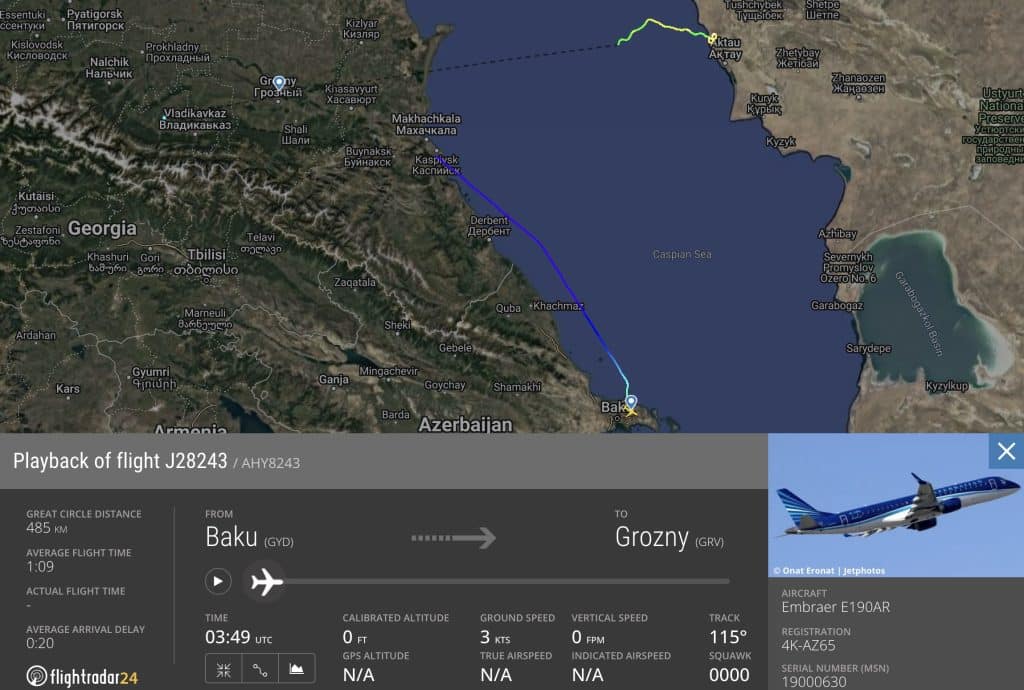On 25 December, the Azerbaijan Airlines passenger plane crashed in Kazakhstan, killing 38. The plane was supposed to land in Russia, but initial investigations suggest that it may have been hit by one or more missiles fired from a Russian air-defense system while it was trying to land in Chechnya.
Details of Flight J2-8243
The plane was flying from Baku, the capital of Azerbaijan, in the early hours of Christmas Day. It was bound for Grozny, the capital of Russia’s Chechen Republic.
There were 67 passengers of different nationalities on board, including Azerbaijani, Russian, Kazakh and Kyrgyz people, plus an Azerbaijani crew.
It was an Embraer 190, which was being operated by Azerbaijan Airlines.
Attempts to Land in Grozny
Survivors say that thick fog hung over Grozny as the plane neared. The pilot unsuccessfully tried to land twice, according to their accounts. On the third approach, multiple explosions were reportedly heard and felt on board.
One passenger described hearing a loud pop that pierced part of the plane’s exterior. Later, the flight attendant, Zulfuqar Asadov, described the strikes as causing panic throughout the plane and said he had suffered an arm injury in a subsequent blast.
A passenger’s video of the inside of the aircraft showed oxygen masks deploying from the cabin ceiling.
Azerbaijan’s transport minister, Rashad Nabiyev, said each survivor noted hearing three explosions over Grozny. He described “external interference” as the probable cause of the damage to the airplane’s structure.
In recent weeks, Russian forces have reportedly carried out drone strikes in and around the Russian Caucasus region, including Chechnya.
Russian authorities responded by working to establish procedures to shut the airspace above Grozny, though it is not clear whether these measures were in place before or at the time of Flight J2-8243’s flight.

Detour to Kazakhstan
After the encounter over Grozny, the pilot chose to divert the aircraft nearly 450 km (280 miles) east to the airport in Aktau, Kazakhstan. It is not clear why the diversion was routed over the Caspian Sea, which was farther than other, closer alternatives.
Russian aviation authorities have said the crew was presented with other potential airports but selected Aktau. Flight-tracking data (from FlightRadar24) indicates that the plane flew erratically before its descent toward Aktau, ultimately crash-landing just kilometers short of the airport runway.

Crash in Kazakhstan
Footage from around the site of the accident showed the aircraft spiraling down steeply, slamming to the ground with great force, slithering along the ground for hundreds of meters while on fire.
Of the 67 people on board, 38 died and 29 survived, some with serious injuries.
Yet a few survivors were spotted emerging from the wreckage on their own. The flight crew is credited with saving countless lives by guiding the plane into a partial landing, though they themselves perished in the tragedy.
Passenger seated toward the back of the aircraft seem more likely to have survived.
Looks like it's official- shot down.https://t.co/SkDdjo4qrH
— Bell_Tent_Owner (@John73080573) December 27, 2024
Was it hit by Russian air defence?
The initial Russian media reports speculated that the plane hit birds. But many Azerbaijani observers and aviation experts speculate that Russian electronic jamming might have affected the plane’s GPS, and that shrapnel from Russian air-defense missiles inflicted lethal damage.
The United States has “early indications” suggesting that Russia was responsible, though no other details were given, White House national security spokesman John Kirby said on Friday.
Azerbaijan’s authorities have not officially blamed Russia, but Azerbaijani government sources quoted by Reuters say the Pantsir-S anti-aircraft system was involved.
Kremlin spokesman Dmitry Peskov has avoided making any definitive comments, saying the circumstances are being investigated and that nothing will be determined until that investigation is complete.
Ongoing Investigation
Both flight recorders have been recovered and are likely to provide clearer details about what led to the cataclysm.
While Russia and Kazakhstan have suggested creating a Commonwealth of Independent States (CIS) investigative committee (a platform whose work is heavily biased towards Russia), officials in Azerbaijan have called for an independent, international investigation.
Following the tragedy, Azerbaijan Airlines and other carriers have canceled certain Russian routes.
The final findings on Flight J2-8243 — and the elements that contributed to its deadly crash in Kazakhstan — are awaiting additional evidence and analysis.
Survivor of Azerbaijan Airlines crash SPEAKS OUT on horrific experience pic.twitter.com/zk5NPREuzb
— Daily Mail Online (@MailOnline) December 27, 2024
